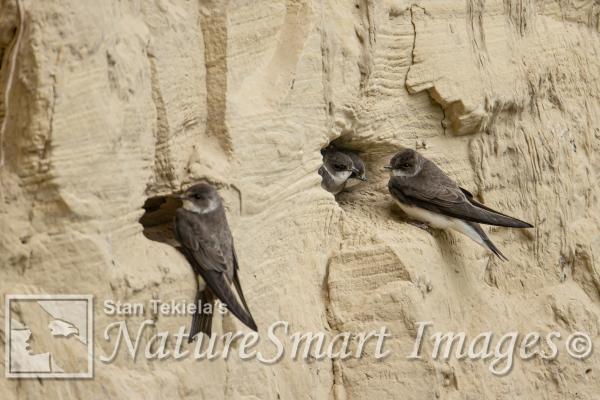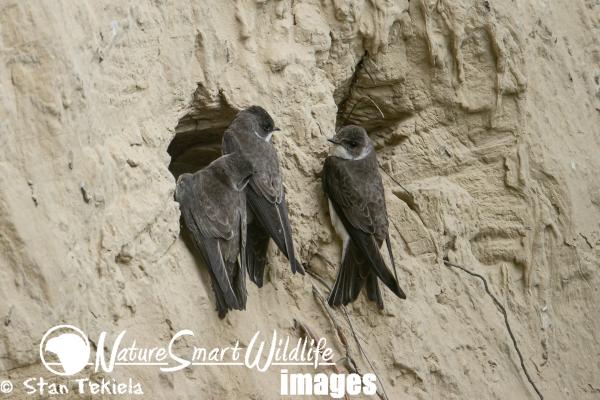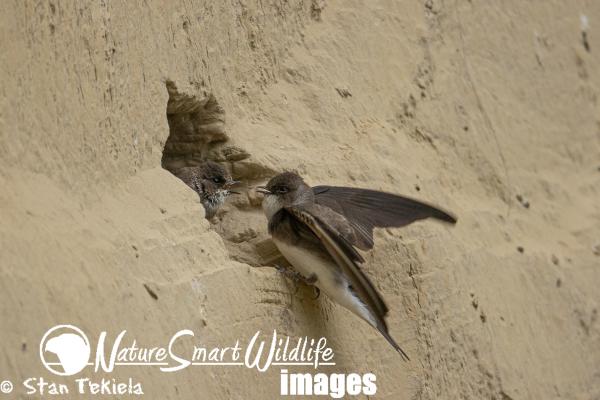View all of the titles in the
NatureSmart Bookstore



by Stan Tekiela
© NatureSmart
August 10, 2020
In any profession there is often a lot of jargon and acronyms thrown around to express a point or to not use long cumbersome names. In the bird world, there are a ton of these, such as GHO standing for Great Horned Owl. In fact, there is an official abbreviation for all 10,000 plus species of bird in the world. However, there is one particular abbreviation that I like to use while leading birding trips. That abbreviation is LBJ, and for those of you in my age category, I am not referring to Lyndon Baines Johnson, the 36th President of the United States. No, when I use the term LBJ for birding it is meant to be a funny, catch all phrase, that means, Little Brown Jobbie, which describes just about any small brown bird.
I was recently photographing a Bank Swallow (Riparia riparia) nesting colony, which is a good example of an LBJ bird. These little brown jobbies really don’t have any outstanding colors or patterns. They don’t have a distinctive shape or flight pattern, so they are the quintessential LBJ.
For all their lack of physical characteristics, the Bank Swallow is a very remarkable bird. It is one of the most widespread birds in the world. They are found in the whole of Europe and the Mediterranean regions, along with North America, South America, Africa and the Indian Subcontinent. In these other regions they are often called Sand Martin or Collared Sand Martin, however they are called Bank Swallow in North America.
Bank Swallows nest in colonies of upwards of several hundred individuals and just like their name implies, they nest in small cavities in an earthen bank. This colony had perhaps 100 plus small cavities in a very tall bank. To capture some images, I needed to climb up the outside of the bank and look over the edge. Sounds simple enough, right? Fortunately, the hillside next to the bank was heavily wooded but extremely steep. I had about 35 pounds of camera gear and a portable blind to drag along with me.
Thank goodness for the trees growing on side of the hill because the ground was so steep that I needed to use the trees to wedge myself behind the tree trunks to stop myself from tumbling back down the hill. Once I got up high enough, I made my way over to the edge of the bank which gave me a clear view of the nesting colony. I set up my fabric blind and wedged myself between the ground and a 8 inch diameter tree. The only thing holding me there was the tree. Without it I would have slide right down the hill.
Like all swallow species, these birds are highly migratory and spend their winters in warm tropical places in South America. I find it amazing that a 4-inch-long bird flies from the tropics of South America to northern states just to nest, raise their young, then turn around and fly back.
But what is really amazing is the fact that these tiny birds excavate their own nesting chamber. They need particular soil types to nest in and the colonies are almost always found near large bodies of water such as rivers. I watched these delicate little birds land on the vertical face of an 80-foot exposed bank and using their tiny beak and feet they slowly scratch and claw at the soil. To me, it looked like this speck of a bird was trying to move a mountain.
Eventually, after several days of battling the mountain, they would have a slight depression where the bird could land and continue the monumental task of attacking the mountain. Eventually they will have a small cavity dug out where they can lay their eggs. The cavity ranges from several inches deep upwards of 4 feet deep. I just can’t imagine these delicate birds being able to move that much sand and dirt to excavate a cavity that is 4 feet deep.
At the end of their nesting chamber, the birds will gather up a few rootlets and a feather or two to make a nest. They will lay about 4 eggs before the female starts to incubate.
Bank Swallows are insect eaters. They catch their meals on the wing, concentrating on the smaller insects such as gnats. They spend a large part of their day flying around catching food before returning to the colony. Each time I would watch them fly back to the colony I couldn’t help but think how amazing these tiny birds are. Until next time…
Stan Tekiela is an author / naturalist and wildlife photographer who travels the U.S. to study and capture images of wildlife. He can be followed on www.facebook.com and Instagram.com. He can be contacted via his web page at www.naturesmart.com.
The nationally syndicated NatureSmart Column appears in over 25 cities spanning 7 states: Minnesota, Wisconsin, Michigan, Illinois, Ohio, New York and Pennsylvania. It is a bi-weekly column circulated to over 750,000 readers.
Wolves
Just the day before, a pack of wolves known as the Wapiti, had found a large bull bison that was weak and injured. Based on its size, this big boy was near the end of its lifespan and the winter weather was taking its toll. For a full day the wolves tried to approach the bison but when the bison...
Moose
It was one of those dark and cloudy winter days in Yellowstone National Park where the clouds are so heavy and low, you feel like you can reach up and touch the cloudy sky. A light wind helped to blow the falling snow with occasional gusts of wind causing swirls of fluffy white snow...
American Badger
It’s funny, I believe the average person knows more about the Honey Badger (Mellivora capensis), a critter of Africa and Southwest Asia than they do about the badger in our own backyard, the American Badger (Taxidea taxus). Social media has a lot to do with the Honey Badger phenomena and...
Backyard Bird Feeding
Winter bird feeding is one of the most common / popular hobbies in America. It is estimated that nearly 60 million Americans feed birds in their yards in winter or summer. That is about 40 percent of all American’s make backyard bird feeding part of their everyday activities. It’s...
Each year, during June and July, Stan Tekiela offers two world-class wildlife photography tours. Here's your chance to learn some tricks of the trade from a top professional.
View all of the titles in the
NatureSmart Bookstore
Check out Stan's latest photos at
NatureSmart Wildlife Images
Do you have any interesting wildlife in your backyard? Any nesting birds, deer, turkeys, reptiles, amphibians, or other unique wildlife? Or maybe a fox or coyote den?
If so, contact Stan at stan@naturesmart.com with your backyard wildlife. If he can get a good photo of the subject, he will send you a print of the photo to hang on your wall.
Order Prints and posters of Stan's photos at
» Prints & Posters
Hear Stan on radio stations all across the Midwest.
» More Info

When he's out in the field, Stan relies on his Vortex Razor binoculars and Vortex Razor spotting scope to help find the subjects for his award winning wildlife photography.

For thirty years, professional wildlife photographer Stan Tekiela has counted on Hunt's Photo and Video to provide him with professional photography equipment.
From tripods to camera bodies and lenses, Hunt's has been Stan's place for everything that he needs. Personal service and prompt shipping means Stan can count on Hunt's to support his professional wildlife photography career.


Professional Wildlife Photographer Stan Tekiela always uses Feeder Fresh in his seed feeders to help keep the feeders and food dry, clean and mold free.
He also uses Feeder Fresh Nectar Defender in all of his hummingbird feeders. It safely keeps nectar fresh longer.